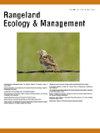Breeding Season Survival and Habitat Use of Scaled Quail in Southeastern New Mexico
IF 2.4
3区 环境科学与生态学
Q2 ECOLOGY
引用次数: 0
Abstract
In recent decades, woody plant cover has increased across many North American grasslands, with important implications for wildlife habitat availability. Scaled quail (Callipepla squamata), a declining ground-dwelling bird species, is known to use woody vegetation in arid and semiarid rangelands. However, it is unclear how vegetation changes due to woody encroachment affect scaled quail space use or if scaled quail perceive various species of woody cover differently. We examined breeding season habitat use and survival of scaled quail in 2018 and 2019 in southeastern New Mexico, USA, in a landscape with various species of shrubs, including mesquite (Prosopis L. spp.), which is thought to have increased over time. We used generalized linear mixed models (GLMMs) to compare vegetation characteristics between used quail locations and random (available) locations. We used resource selection functions (RSF) to examine selection for dominant vegetation cover types and anthropogenic features at the third order (within home ranges). We also investigated the influence of third-order selection and weather on quail survival (adult and brood). We found that both brooding and nonbrooding quail preferentially used locations with greater visual obstruction and high densities of tall (≥1.5 m) shrubs relative to availability. Within home ranges, scaled quail selected for proximity to mixed shrub cover, mesquite cover, and bare ground but demonstrated weak avoidance of herbaceous-dominated patches. However, third-order space use did not affect daily survival probability for either adult quail or broods. The only variable related to quail survival was daily average wind speed, which was positively associated with brood survival. Our findings highlight the importance of shrubs as a source of visual, thermal, and olfactory cover for scaled quail. In increasingly shrub-dominated communities, we recommend that scaled quail management plans prioritize practices that create spatially and compositionally diverse vegetation, including patches of tall, dense shrubs.
新墨西哥州东南部鳞鹌鹑的繁殖季节、生存和生境利用
近几十年来,北美许多草原的木本植物覆盖面积有所增加,这对野生动物栖息地的可用性具有重要意义。鳞状鹌鹑(Callipepla squamata)是一种逐渐减少的陆栖鸟类,已知在干旱和半干旱的牧场上使用木本植被。然而,目前尚不清楚由于树木入侵而导致的植被变化如何影响尺度鹌鹑的空间利用,或者尺度鹌鹑是否对不同种类的树木覆盖有不同的感知。我们研究了2018年和2019年美国新墨西哥州东南部有鳞鹌鹑的繁殖季节栖息地利用和生存情况,在一个有各种灌木的景观中,包括豆科植物(Prosopis L. spp.),人们认为豆科植物随着时间的推移而增加。我们使用广义线性混合模型(glmm)来比较使用过的鹌鹑栖息地和随机(可用)栖息地之间的植被特征。我们使用资源选择函数(RSF)来研究三阶(在原始范围内)优势植被覆盖类型和人为特征的选择。我们还研究了三级选择和天气对鹌鹑成虫和幼崽存活率的影响。研究发现,孵蛋鹌鹑和非孵蛋鹌鹑均倾向于选择视觉障碍较大、高灌木(≥1.5 m)密度较高的栖息地。在家园范围内,鳞状鹌鹑选择靠近混合灌木覆盖、豆科植物覆盖和光秃秃的地面,但对草本植物为主的斑块表现出微弱的回避。然而,三阶空间的使用对成年鹌鹑和雏鹑的日常存活率没有影响。与鹌鹑存活率相关的唯一变量是日平均风速,而日平均风速与雏鸟存活率呈正相关。我们的研究结果强调了灌木作为鳞片鹌鹑视觉、热和嗅觉掩护来源的重要性。在日益以灌木为主的群落中,我们建议规模化的鹌鹑管理计划优先考虑创造空间和成分多样化的植被的做法,包括高大、茂密的灌木斑块。
本文章由计算机程序翻译,如有差异,请以英文原文为准。
求助全文
约1分钟内获得全文
求助全文
来源期刊

Rangeland Ecology & Management
农林科学-环境科学
CiteScore
4.60
自引率
13.00%
发文量
87
审稿时长
12-24 weeks
期刊介绍:
Rangeland Ecology & Management publishes all topics-including ecology, management, socioeconomic and policy-pertaining to global rangelands. The journal''s mission is to inform academics, ecosystem managers and policy makers of science-based information to promote sound rangeland stewardship. Author submissions are published in five manuscript categories: original research papers, high-profile forum topics, concept syntheses, as well as research and technical notes.
Rangelands represent approximately 50% of the Earth''s land area and provision multiple ecosystem services for large human populations. This expansive and diverse land area functions as coupled human-ecological systems. Knowledge of both social and biophysical system components and their interactions represent the foundation for informed rangeland stewardship. Rangeland Ecology & Management uniquely integrates information from multiple system components to address current and pending challenges confronting global rangelands.
 求助内容:
求助内容: 应助结果提醒方式:
应助结果提醒方式:


